
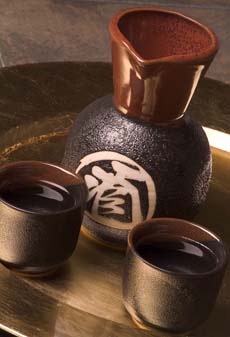 Enjoyed for 4,800 years...and perhaps the reason ancient man stopped roaming in China and settled down to farm.
Enjoyed for 4,800 years...and perhaps the reason ancient man stopped roaming in China and settled down to farm.
October 2005 |
 |
Product Reviews / Main Nibbles / Wine
Saké 101
Learn About Saké, An Ancient Libation
Saké (yes, with an acute accent) is about as old as any food we can pin a date on: a 6800-year-old beverage. Saké-making implements have been discovered in the Yangtze River Valley in China, dating back to 4800 B.C.E.—about the time that nomadic man settled down to farm. According to some anthropologists, the reason for this lifestyle change was so that man could grow rice to turn into saké, ensuring he could enjoy it on a regular basis. What some men will do for a drink!
Saké is made from four ingredients: rice, water, yeast and koji, an enzyme particular to saké-making. Saké is fermented and brewed like beer, and served like wine. It is also characterized as a wine because of its higher alcohol content.
There are over 14,000 different sakés produced by 1800 sakéries worldwide. Most are in Japan, but almost every part of the world has a sakéry. There are four in the United States—three in California and one in Oregon—producing about 200 different sakés. Worldwide, one out of three glasses of wine consumed is a saké (saké consumption by the large Chinese population adds a lot to these figures).
In the United States, just two out of one hundred glasses of wine are saké, but domestic sales over the past 10 years have quadrupled. With more understanding of how to select and enjoy saké, the numbers will grow. Today, saké knowledge in the U.S. is where wine knowledge was forty years ago: a few people know a lot about the topic, many of us drink it but don’t know much about it.
What we do know is that when we pick up the sake list at a Japanese restaurant, it’s in English; but for all it’s worth, it may as well be in Japanese. We read the words but don’t understand them, and find the marketer’s names and descriptions useless if not annoying (“Moonlight Blossom is a creamy and rich saké, with notes of spice and citrus...”). We end up playing eeny-meeny-miny-mo....and because it seems that one never finds the same saké at the next restaurant, we end up picking blind all over again.
Despite challenges like this that are shared by many, saké enjoyment is growing rapidly due to three trends:
- The popularity of Japanese restaurants, sushi bars, and other Asian cuisines; plus fusion dishes at non-Asian restaurants.
- The healthier properties of saké: unlike most wines, saké has no sulfites, to which as many as 25 percent of Americans are allergic. Saké has one-third the acidity of wine, for people who seek lower-acid foods.
- In the search for new and innovative cocktails, saké is a versatile mixer. It has become a favorite of bartenders and patrons alike. If you’d like to mix some of your own saké cocktails, click here for an entire menu full, courtesy of Momokawa Premium Sake.
Saké can be drunk like wine with meals: with Asian cuisines, seafood and vegetable dishes. And of course, it can used in cooking like wine.
How Saké is Made
Saké originated in China, but brewing techniques were dramatically improved upon over the centuries by the Japanese.
As with wine, the finest saké starts with the finest ingredients: the purest water, premium saké rice, special yeast, and koji. It starts with getting at the heart of the matter—or more precisely, the heart of the rice kernel.
- Alcohol is produced when starch is converted to fermentable sugar. The starches in rice are concentrated in a dense starch packet at the center of the rice kernel. For premium and superpremium saké, milling (or polishing) removes the undesirable outside grain of the rice kernel, which consists of protein and fatty acids that do not convert to alcohol. Polishing these away exposes the desirable heart of the grain.
- The more grain that is milled away, the better the saké. For ginjo (premium) saké, 40% of the grain is milled away leaving 60% of the original kernel. For daiginjo (superpremium daiginjo) saké, at least 50% is milled away.
- The milled kernels are then washed and soaked to bring up their water content, and then steamed. Part of the steamed rice is reserved for cultivating the koji enzyme.
Koji is the key differentiator in making saké. Koji mold is cultivated on a bed of steamed rice; the mold eats its way into the rice. As this occurs, the enzymes in the mold break down the rice’s starch molecules into smaller sugar molecules that are food for the yeast used in the fermentation process. The process, which takes about two weeks, requires proper temperature and humidity and takes place in a special yeast starter room that resembles a sauna.
Steamed rice and koji are then sent to the yeast starter room, and moto (yeast starter) is prepared. Moto is added over a period of 4 days to the rice, water and koji. Fermentation occurs over a period of 18 to 32 days. The saké is then filtered, aged (for anywhere from less than three months to more than nine months, depending on quality), pasteurized and bottled.
Types of Saké
Categories
The broad categories of saké are junmai and honjozo.
- Junmai means that no distilled alcohol has been added.
- Honjozo means that distilled alcohol has been added (no more than 5% by volume).
- There are sakés that have a higher percentage of alcohol than honjozo sakés, but they are almost never imported into the United States.
- By law, sakés made in the United States cannot add distilled alcohol; so all domestic-made sakés are junmai style.
In Japan, about 88% of all sakés made have distilled alcohol added (honjozo). For economy (futsu) sakés, the distilled alcohol is generally processed grain alcohol. For the premium and superpremium sakés, it can be distilled alcohol collected from the esters during fermentation and distilled down. They are added back during the blending of the saké.
Quality
Within the two broad categories of saké, there are levels of quality based on how much of the outer kernel of the rice is milled away, the quality of all ingredients, the complexity of processing, and the length of aging.
| Sake Category |
Varieties Available |
Description |
Futsu Saké
Economy Sake
|
- Junmai Futsu saké
(no added alcohol)
- Honjozo Futsu saké
(alcohol added)
|
- Rice milled down to 70% of
the original kernel size.
- Usually aged for less than 3
months.
- Typically served warm.
|
Ginjo Saké
Premium Sake |
- Junmai Futsu saké
(no added alcohol)
- Honjozo Futsu saké
(alcohol added)
|
- Rice milled to less than 60%
of its original kernel size.
- Better koji and yeast and more refined processes than economy saké, producing a more smooth wine.
- Aged in temperature-controlled stainless steel tanks for at least six months.
- Domestic premium sakés are $10 to $15 per 750 ml bottle; imported are $20-plus.
|
Daiginjo Saké
Ultrapremium Sake |
- Junmai Futsu saké
(no added alcohol)
- Honjozo Futsu saké
(alcohol added)
|
- Rice milled to less than 50% of its original kernel size.
- Better koji and yeast and more refined processes than ginjo saké, adding complex aromas and tastes.
- Aged in temperature-controlled stainless steel tanks for at least nine months.
- Ultrapremium sakés are $20 to $40 per 750 ml bottle; the finest sakés from the best producers can be $80 or more.
|
| Variations |
Varieties Available |
|
Nigori Saké
Roughly Filtered (Cloudy) Sake
|
- Futsu (Economy)
- Ginjo (Premium)
- Daiginjo (Ultrapremium)
|
- Filtered through a rough weave filtration system (old-style, prior to modern technology), so one-third
of the contents are microscopic particles of rice which settle on the bottom of the bottle.
- The bottle is shaken before
pouring, creating a milky white saké.
- Naturally sweet, it goes well with non-Japanese spicy foods and desserts.
|
Genshu Saké
Undiluted (Cask Strength) Sake |
- Futsu (Economy)
- Ginjo (Premium)
- Daiginjo (Ultrapremium)
|
- Little water added to the saké.
- The alcohol percentage is thus much higher—around 18% versus 15% for a typical nigori saké.
|
Infused Saké
|
- Futsu (Economy)
- Ginjo (Premium)
- Daiginjo (Ultrapremium)
|
- Unique to the United States,
flavors are added during the
blending process.
- Used for nouvelle cocktails.
- Tend to be lower in alcohol
content than classic sakés.
|
| |
|
|
How to Serve Saké
Remember this expression: Good saké is always served chilled, mediocre saké can be served warm, and bad saké should be boiled.
Chilled premium sakés were first introduced in the late 1960’s. Saké-making technology, particularly in rice milling, had improved so dramatically that it enabled sakémakers to make sakés so delicate they are actually damaged by heat. Today, artisanal sakémakers make wines that are as rare and sought-after as the finest Burgundies (and in fact, made in much smaller quantities).
But, just as one does not drink wines from the Domaine de la Romanée-Conti on a daily basis, there are sakés at all levels, each with a time and place:
- Economy saké is best drunk warm: heating covers up imperfections. There’s no reason to categorically refuse a warm carafe of economy saké: some brands are quite pleasant (others, not). The problem is, since they’re sold in bulk containers that fit into the a heating device, you never know what the house is serving. If you like it—and especially if you don’t—try to find out the brand and check at the next restaurant.
- Premium and ultrapremium sakés should never be warmed. They should be served at at 45° degrees Fahrenheit.
- Like all wine, beer, and spirits, saké should be stored in a cool place, out of strong light.
- Like beer, saké is not brewed to age and is best when fresh.
- Once opened, saké is like wine: it will be at peak for about a week in the refrigerator and then begins to lose its qualities. However, because of the high alcohol content, opened bottles of fine saké can keep for a long time in the refrigerator and remain perfectly drinkable.
Glass vs. Cup vs. Box
There’s quite a choice these days. Depending on your personal style and how often you drink saké, you may want one or all of the different types of saké vessels. With the exception of the Riedel glasses, all types are available across a broad spectrum of price points.
- Saké cups of ceramic, stone, glass or porcelain are the most familiar vessels to American sake drinkers. Like teacups, they vary in design: some are squatter, some are taller, some are traditional, some are highly stylized. They can be purchased with matching carafes.
- The masu, or wooden box, was a traditional rice-measuring device, typically made from aromatic cedar—which imparts aromas to the saké. Today boxes also can be found in fancier lacquer.
- A highball glass or tumbler is perfect for saké on the rocks.
- The same for stemware: any wine glass will do. In a wine glass (or the Riedel glass below), the temperature of the saké gradually increases, evolving the aroma and flavors.
- Riedel, makers of fine stemware with specific shapes to enhance each kind of wine, makes a Riedel Vinum Daiginjo Saké Taster Glass with every contour engineered to heighten the enjoyment of fine saké.
|
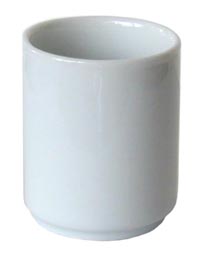 |
Sake cup available at
QuickSpice.com. |
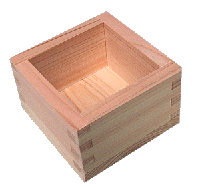 |
Masu, or cedar box available at
QuickSpice.com. |
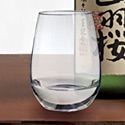 |
| Riedel Saké Glass at Amazon.com. |
What About Hot Saké?
Fine saké is typically served cold (reishu), but many people have a preference for hot (atsukan) saké. Previously, the hot varieties were available in rougher, jug-wine quality; but today, ask about better brands with characteristics that work well warmed Hoyo Manamusume (translation: Farmer’s Daughter), a junmai saké brewed by Uchigisaki Shuzo Company and Shusen (translation: Three Dots), a junmai from the Kamoizumi Brewery.
- “Farmer’s Daughter” uses the rare Manamusume rice variety grown only in the Miyagi Prefecture. It is brewed into a silky softer sake with flavors of milky coconut, fine flower pollen, yellow apple, melon and pineapple, with hints of white pepper and cardamom. 720 ml bottle, approximately $20.99.
- “Three Dots” is aged almost two years before shipping, giving it a very faint amber color. It is nutty and woodsy, with predominant macadamia and Brazil nut notes joining subtle overtones reminiscent of white chocolate and coffee. A 900 ml bottle is approximately $26.99.
Heating the saké increases its dryness which some people find pairs better with the clean flavors of sashimi; and similarly cuts the richness of heartier dishes.
Both of the sakés above are very fine quality and can be enjoyed cold as well. In Japan sake is served cold, warm or hot, depending on the preference of the drinker, the quality of the saké and the season. Warm or hot saké has been enjoyed in Japan for hundreds of years; the practice became widespread during World War II to mask the rough flavor of low-quality saké that was made due to the scarcity of quality ingredients. Today, most sake made is of higher quality,
TO HEAT SAKE: Tempting as it is to put it in the microwave, place the beaker (tokkuri) in water that has been heated almost to boiling. Generally, warm saké should be about 104°F. If bubbles gather on the sides of the tokkuri but do not rise to the surface of the water, the saké is warm. If the bubbles do rise, the saké is hot.
Learning More About Saké
- Just as you wouldn't have one bottle of wine in the house, you also need several different kinds of saké. So find the wine store in your town with the largest selection—and hopefully the most knowledge.
- Based on the selection, get your friends together to taste a dozen bottles (up to twenty people can taste a dozen bottles if portions are poured carefully).
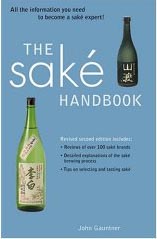 Get a good basic book, like The Saké Handbook. Get a good basic book, like The Saké Handbook.- Ask your favorite Asian restaurant to prepare a special dinner with matching sakés for your group.
- Check local wine-tasting groups to see if there are scheduled tastings.
- If you’re in a major city, a sake importer should be willing to hold an event for a group of 20 or more people if you have the premises: a club or a restaurant, for example.
- Keep your tasting notes in your PDA so the next time you’re confronting that saké list, your studies will pay off.
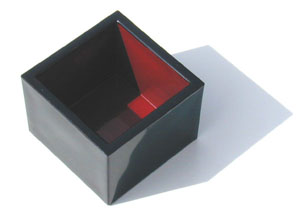 |
|
Drink your sake from a spiffy lacquer. version of the
traditional masu, or cedar box. From QuickSpice.com. |
|
Lifestyle Direct, Inc. All rights reserved. Images are the copyright of their respective owners.

|








 Get a good basic book, like
Get a good basic book, like 